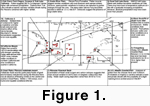The middle Pliocene has been described as the last period of geological time
that displayed greater sustained warmth and reduced climatic variability over a
time period greater than any Quaternary interglacial (Dowsett
and Poore 1991; Dowsett
et al. 1996). Geological proxy evidence supporting this assertion includes
sea surface temperatures (SST) reconstructed from planktonic foraminifera (Dowsett
and Poore 1991; Dowsett
et al. 1992; Dowsett
et al. 1996; Raymo
1994), ostracods (Cronin
1991; Forester
1991), siliceous microfossil records (Morley
and Dworestzky, 1991; Barron
1992, 1996),
terrestrial vegetation records (Thompson
1991; Heusser
and Morley 1996; Thompson
and Fleming 1996) and numerous records of higher-than-present sea levels (Dowsett
and Cronin 1990; Brigham-Grette
1994; Zubakov
and Borzenkova 1990). As a result, the middle Pliocene represents a unique
time period in which to examine the behaviour of the Earth’s climate system
under a regime of greater-than-present warmth.
A relatively precise stratigraphy, wide geographical distribution of sample
sites, and numerous extant climatic boundary conditions all combine to make the
middle Pliocene an ideal time period for palaeoclimatic modelling studies using
general circulation models (GCM; Dowsett
et al. 1999). With anthropogenic greenhouse gas emissions forcing greater
warmth (IPCC
1995), significant potential benefit exists in the careful investigation of
past warm periods in Earth’s history, such as the middle Pliocene.
Furthermore, palaeoclimatic modelling investigations of this interval provide us
with an opportunity to assess the validity and robustness of predictions
produced by GCM that are being used to model past, present, and future climates
alike (Chandler
et al. 1994; Sloan
et al. 1996; Haywood
et al. 1999, 2000a,
2000b).
This paper describes the results of a new palaeoclimatic modelling study,
focused on the USA, for the middle Pliocene using a state-of-the-art GCM.
Previous GCM studies of the middle Pliocene have been carried out by Chandler
et al. (1994), Sloan
et al. (1996), and Haywood
et al. (1999, 2000a,
2000b).
However, this is the first to examine, in detail, the nature and dynamics of the
palaeoclimate and the validity of model predictions on a regional scale.
 The
geological record of the USA during the middle Pliocene is diverse and well
suited for the regional assessment of GCM predictions (Figure
1). A wealth of geological data are available, derived from tectonic basins
that contain long sedimentary records of palaeoenvironmental change. In
addition, numerous localities display evidence for Pliocene lacustrine, fluvial,
and shallow marine environments (Thompson
1991; Thompson
and Fleming 1996).
The
geological record of the USA during the middle Pliocene is diverse and well
suited for the regional assessment of GCM predictions (Figure
1). A wealth of geological data are available, derived from tectonic basins
that contain long sedimentary records of palaeoenvironmental change. In
addition, numerous localities display evidence for Pliocene lacustrine, fluvial,
and shallow marine environments (Thompson
1991; Thompson
and Fleming 1996).
 The
geological record of the USA during the middle Pliocene is diverse and well
suited for the regional assessment of GCM predictions (Figure
1). A wealth of geological data are available, derived from tectonic basins
that contain long sedimentary records of palaeoenvironmental change. In
addition, numerous localities display evidence for Pliocene lacustrine, fluvial,
and shallow marine environments (Thompson
1991; Thompson
and Fleming 1996).
The
geological record of the USA during the middle Pliocene is diverse and well
suited for the regional assessment of GCM predictions (Figure
1). A wealth of geological data are available, derived from tectonic basins
that contain long sedimentary records of palaeoenvironmental change. In
addition, numerous localities display evidence for Pliocene lacustrine, fluvial,
and shallow marine environments (Thompson
1991; Thompson
and Fleming 1996).